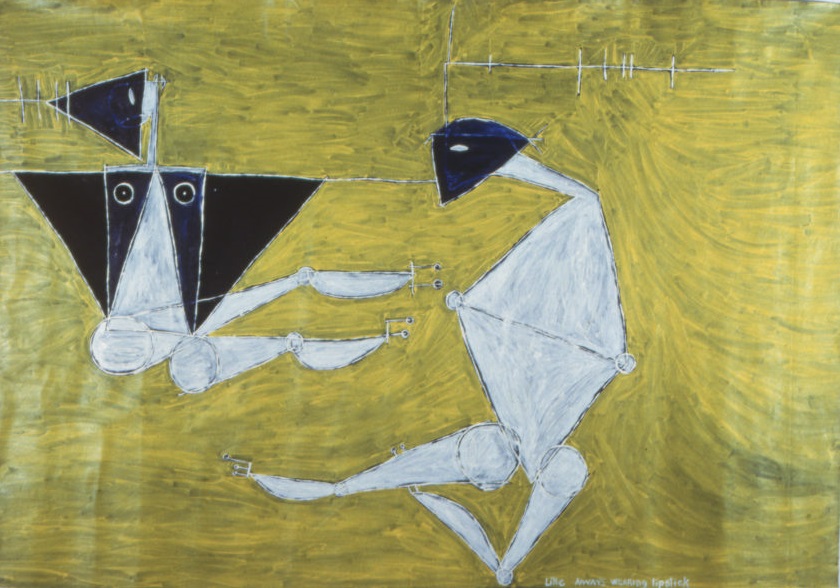ARTISTS Leonie Arnold, Ingrid Banwell, Heather Busch, Nancy de Freitas, Charo Oquet, Angela Porteous, Pauline Thompson, Bianca Van Rangelrooy, Christine Webster, Delyn Williams CURATOR Jenny Neligan ORGANISER Govett-Brewster Art Gallery, New Plymouth OTHER VENUES Govett-Brewster Art Gallery, 7 June–16 September 1984
Curator Jenny Neligan, the Director of Wellington's Bowen Galleries, begins her catalogue introduction: 'We drudged our way through the seventies and now thanks to women those boring years are over.' Neligan—who opened Bowen in 1981 with a Debra Bustin show—is known for championing emerging artists. Her show of eleven emerging women artists presents, 'the spirit, colour, and energy of the eighties'. She selects the works with Dick Bett, the Govett-Brewster Art Gallery Director.
New Women Artists is not uniform in medium or method, so Neligan's curatorial agenda is hard to pin down. It includes installations, photos, paintings, ceramics, and music videos. Styles range from expressionism to realism, from surrealism to abstraction.
Some of the work is expressionist. Dominican-born painter Charo Oquet's colourful expressionist canvas, The Snake Tamer (1984), features a powerful archetypal female figure. Debra Bustin's installation is arranged behind a large meshed net like a 'jungle environment'. In the Evening Post, critic Ian Wedde describes it as 'a ghoulish garden of delights, with its gaping fish, sadly shackled banshees, trapezing skeletons, a bird whose over-evolved tail drags it down, and so forth'.
Some of the work is more formal, for instance Bianca van Rangelrooy's brass, rod, and paper constructions and Ingrid Banwell's painted customwood constructions.
Some of the work has an obvious feminist agenda. Angela Porteous's Hang-up (1984) is an installation of twenty-five moulded wax female legs suspended by meat-hooks from a square metal grid. The legs are covered in mutton-cloth stockings and wear pale blue high heels. Porteous says of her work, 'The women's body is the vehicle by which she not only perceives herself in society but by which society views her.' Christine Webster's photos of a young man and Nancy de Freitas's sombre photo-realist paintings have an androgynous psychological charge.
Heather Busch's intricate, symbolic surrealist canvases are sometimes horrific. In her statement, she writes, 'The Hostage is a young woman so stunned with terror that her scream is locked and soundless behind the magnifying glass that protects the vulnerability of her open mouth.' While her triptych, The Swing (1983), depicts 'recollections in the life of a female, with interactions of old and young'. Yet, Busch also writes, 'It is important to me that men don't feel negative and excluded by this show'. (Busch will later illustrate the bestseller Why Cats Paint, Burton Silver's humourous account of feline creative capers.)
In her review in Art New Zealand, critic Priscilla Pitts questions Neligan's inclusion criteria: 'Is the fact that all these artists are women a good and sufficient reason for grouping them together in a single show?'
New Women Artists opens at the Govett-Brewster, then travels to Wellington City Art Gallery, where several artists have strong connections. Bustin and Porteous live in Wellington. Leonie Arnold was born there and studied at Wellington Polytech's School of Design. Bustin and Webster have had previous solo shows at Wellington City Art Gallery—both in 1982.
In connection with the show, City Gallery Wellington runs a series of lectures and panels. Janet Paul speaks on 'Pioneer Women Artists: Early New Zealand Women Artists', Catherine Wilson on 'The Connections Between Feminism and Religion', and Sue Kedgley on 'The Ever-Widening Gender Gap'. There's also a panel discussion, 'Women's Work—Women's Imagery?' with Angela Porteous, Heather Busch, Jenny Neligan, and City Gallery Director Ann Philbin. TV's Kaleidoscope programme interviews several artists for a segment on 'Women's Art.'














![Angela Porteous <em>Hang-Up</em> 1984 [installation at Govett-Brewster Art Gallery, 1984]](https://citygallery.org.nz/wp-content/uploads/2018/07/NWA_Govett_legs-198x300.jpg)












![Angela Porteous <em>Hang-Up</em> 1984 [installation at Govett-Brewster Art Gallery, 1984]](https://citygallery.org.nz/wp-content/uploads/2018/07/NWA_Govett_legs.jpg)
